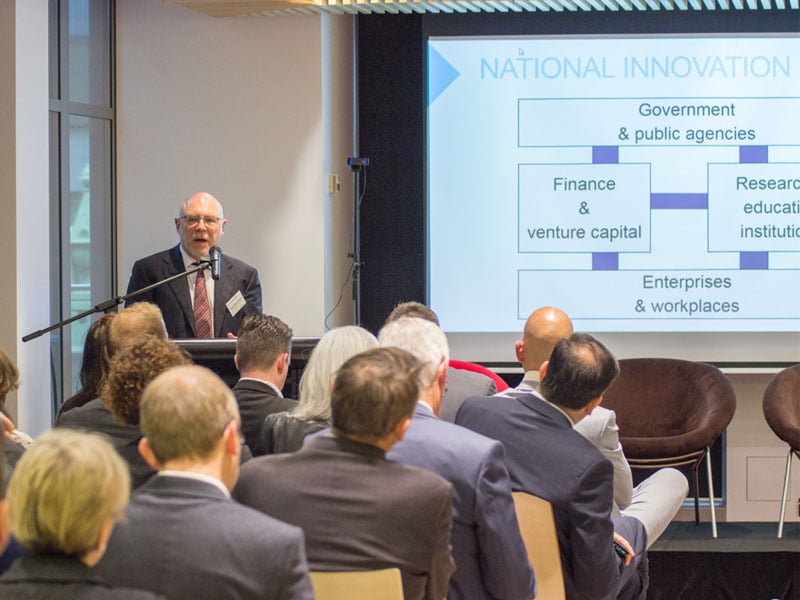A Senate report on Australia’s Innovation System tabled on the last parliamentary sitting day of the year makes excellent reading for anyone who wants to understand the context behind the Prime Minister’s statement on innovation today.
And for all the bipartisanship being thrown at the ‘agile’, ‘creative’ and ‘innovative’ industries, the report does provide a map of the policy demarcation between the coalition and Labor.

Malcolm Turnbull will unveil his National Innovation and Science Agenda at the CSIRO’s Canberra headquarters today, a raft of new policy measures that will collectively have three ambitions:
- To make the Australian economy more creative and agile;
- To make it easier for start-ups to raise capital, more attractive for angel investors to invest and;
- To encourage greater collaboration between business and research institutions
The Senate Economics committee’s contribution released last week is on-message with these three goals, although its recommendations on how to get there drew a dissenting statement from its Coalition members.
(And it is certainly worth reading the excellent report by the University of Technology Sydney Business School dean, Professor Roy Green that was commissioned by the committee. For a deep-dive into the reasoning behind the policy statement today, Prof Green’s report is biblical.)
It is on R&D funding recommendations that the economics committee parts ways with Government’s thinking. The Senate committee’s first recommendation calls for Australia to lift its investment in research and development to 3 per cent of GDP – up from a current level of about 2.1 per cent.
Not going to happen. While the Prime Minister will announce $100 million in new money to the CSIRO today (which is great news for its previously de-funded Data61 program focused on data sciences), it has no intention of implementing a target.
This government doesn’t believe in artificial targets, as the coalition Senators on the committee make clear:
“Until now Australia has resisted the adoption of R&D targeting. The Productivity Commission dismissed calls for Australia to adopt an R&D target in a major study into science and innovation. It pointed out that R&D targeting is conceptually flawed and has a history of failure,” the dissenting statement said.
“Targeting an increase in an input measure, such as spending on R&D makes little sense. Like any cost to business its impact on productivity depends on the quality of the spending. As a consequence, Australia has in modern times focussed on output measures — in particular productivity.”
In most other ways, the recommendations of the Economics committee report map to the bipartisan thinking on innovation by both sides of post-Abbott politics. The differences are measured at the margin (except perhaps, as it related to NBN – the unspoken giant of the conversation.)
R&D spending is where the Opposition will target government. This is why Labor methodically outlines every cut to research spending since the Abbott-Turnbull government came to power, and this is why the CSIRO spending increase was leaked to The Australian today.
The other potential point of difference will relate to STEM education. But it will be a matter of degree. Labor has announced a policy for 100,000 HECS-free places for STEM students, and some aspirational goals around primary and secondary curricula.
We will have to wait and see what Mr Turnbull has in mind for STEM in his National Innovation and Science Agenda today.
In the meantime, I publish below the list of five recommendations in full from the report in the Senate last Thursday.
You will see from recent policy debates, there is a lot of common ground – from the need for stable, long-term strategic policy development to the creation of an independent oversight agency and better coordination infrastructure for public-private collaboration on innovation.
No-one needs reminding that the depth of the policy debate – and the level at which the debate is happening – simply would not have taken place even a few months ago.
There has never been a more exciting time – as the Turnbull stump speech goes – to be involved in the Australian innovation sector.
This is yet another reason to be cheerful on this beautiful day.
Senate Economics References Committee report on Australia’s Innovation System:
Recommendation 1
The committee recommends that the Australian Government commits to maintaining stable, coherent and effective administrative arrangements for innovation policies and programs, based on a long-term strategic framework and a target to lift investment in research and development to three per cent of GDP.
Recommendation 2
The committee recommends the establishment of an independent government agency with a mandate to administer and coordinate innovation system policies and programs. Such a body would be responsible for maintaining a continuous and consistent approach to innovation policy across the whole of government.
Recommendation 3
The committee recommends that the Australian Government, as part of its long-term innovation strategy, includes policy options to address the structural and strategic barriers that inhibit innovation, including: measures to enhance collaboration and the free flow of knowledge between the university system and the private sector; increasing the size of the research and development workforce employed in industry; and ensuring that public funding to support science, research and innovation is long-term, predictable and secure.
Recommendation 4
The committee recommends that the Australian Government, working in collaboration with State and Territory governments, adopt a range of measures to support the role of local and regional innovation ecosystems.
Recommendation 5
The committee recommends that the education system be accorded a central focus in the Australian Government’s long-term innovation strategy, thereby acknowledging the central importance of the interplay between the STEM subjects and the humanities, social sciences and creative industries.
Do you know more? Contact James Riley via Email.

